A couple of centuries ago, chinchillas were on the verge of extinction - it was destroyed because of the very valuable fur, but gradually the situation changed for the better for the animal and from the status of the hunting trophy this rodent migrated to our homes as a pet and everyone's pet.
But so that the animal feels comfortable, healthy and fun, you should know how to properly him, what to feed and whether it is possible breeding at home?
Table of contents
Maintenance and care of a chinchilla at home
So, how to keep chinchilla at home, for example in an apartment? The life of a chinchilla at home of this cute rodent can be 25 years or more, which distinguishes it from our usual hamsters and guinea pigs, living no more than 5 years.
Chinchilla is best bought at 2 months - the animal will get used to the new environment and owners more quickly than it is already mature and mature.
If you purchased a small rodent and wondered if it could be tamed, then of course you could. In the first days, just leave the animal alone - it will get used to the new house, the smells and you.
Gradually start taming it, in your own hands. - go to the cage and in the palm of your hand in front of the open door of the cage, offer the chinchilla a treat, for example, a piece of sweet apple.
The animal will surely take it from his hand, even if not immediately, so in a few days - a tamed chinchilla will often sit on your shoulder and happily respond to your attention to his person. Believe me, it is not so difficult to care for her.
With regard to the selection and arrangement of the cell has its own rules and recommendations. At the very beginning, the size of the cage per animal is 60 by 50 cm, 60 cm or more in height. All locks and bolts are strong, best of all not metal, but metal, because chinchilla rodents and soon from wooden rods can remain only some sawdust.
It is best to place the cage away from the central heating radiators, while the temperature in the room should be within 20-22 degrees, without a draft and away from direct sunlight.
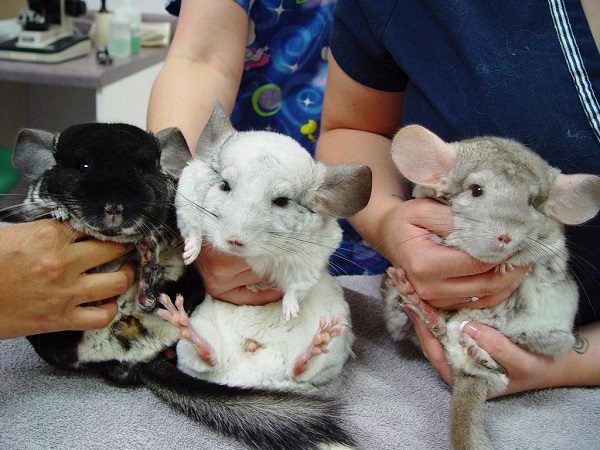
The animal bathes in special sand, but not in the water - it is not recommended to put a font with sand in a cage, but it should be kept separate, arranging the animal a so-called “bath day” with a frequency of 2-3 days.
Cage equipment: how to keep clean?
Regarding the cage equipment and what should be in it, it is recommended to put in it a small house where the animal can retire, wooden shelves and stairs for games, a hanging water bowl and a feeding trough, which are attached from the outside.
It is recommended to put salt and mineral stones in the cage - they serve the animal as a natural sharpener for teeth and a source of salt and vitamins in the body, sennitsa with dry hay and grass, and recommended to fill the floor of the cage with a special filler made of wood and not adhering to the legs of the animal .
If the dimensions of the cage allow it, you can install a running wheel, toys made of wood, preferably birch, but not pine or spruce, rings and a hammock. It is necessary to learn the rules regarding what can not be done with chinchillas.
What can not be done to extend the life of the animal?
The first thing to remember is that bathing chinchillas in the water is prohibited, since there is special sand for this, in which the animal splashes with pleasure.You should not keep it in a close, small cage - it is an active rodent and a sedentary lifestyle will lead to obesity and death.
Wherein for chinchilla it is important to move exactly up, movement from the top to the bottom shelf and vice versa, and therefore it is optimal to choose a high cell shape rather than an elongated one.
You should not let out this handsome man walking around the apartment on his own - as a result, damaged furniture, wiring and books are provided for you.
Also, do not give chinchilla often have a lot of nuts and fresh food - the optimal diet is just granulated food, hay. Nuts, fresh fruit, seeds should serve as such a delicacy, rather than a daily diet.
If you purchased a pair of chinchillas, then never plant a female to a male, especially if the boy is older and the girl is less than 6 months. At this time, the female is not yet ready for childbirth, and therefore an early pregnancy will only lead to problems with her health.
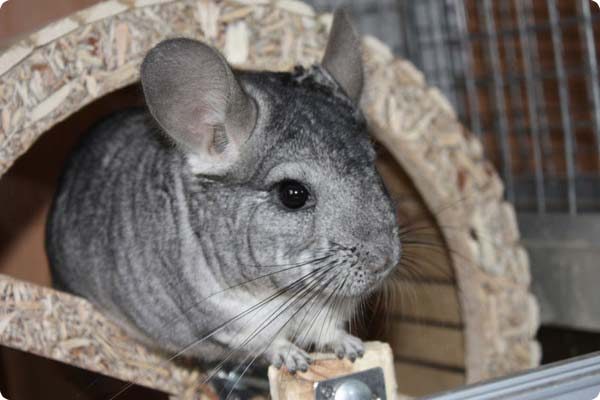
Try to travel less with chinchillas - for them the slightest noise, vzryazgi and travels are just another stress that does not in the best way affect your pet.
Chinchilla does not tolerate cold and therefore keep it indoors, where below 14 degrees is deadly, although it is also not necessary to overdo it with heat, since these rodents are very sensitive to overheating, as well as the sun's rays, which can lead to heat or sunstroke.
What to feed a chinchilla and how many times a day?
Chinchillas belong to the order of herbivores, they are real representatives of the family of rodents - at home, this point should be taken into account and the appropriate diet should be chosen.
In relation to food - in the stores for chinchillas today there will be no problem to choose dry, granulated food, made up taking into account the preferences of the rodent and with the composition of macro, microelements and vitamins it needs.
Many experts do not recommend buying and giving chinchilla vitamins separately, although during pregnancy and feeding the offspring the female can be transferred to a vitamins-enhanced diet.
In the diet of chinchilla should be present and hay - it can be harvested independently, collecting in the field such herbs as clover, dandelions, alfalfa. If you buy hay in a pet store - it should be dry, clean, without unnecessary unpleasant smells of mold.
As an additive, you can enter and sprigs of birch or willow, crimson twigs or apple, currant or linden. In no case do not give branches of oak and cherry, as well as trees that produce resin - pine, spruce.
Pure, boiled or filtered water must be present in the cage - in nature, chinchillas get it from food, but due to the fact that at home the animal receives dry food, moisture is simply necessary for it.
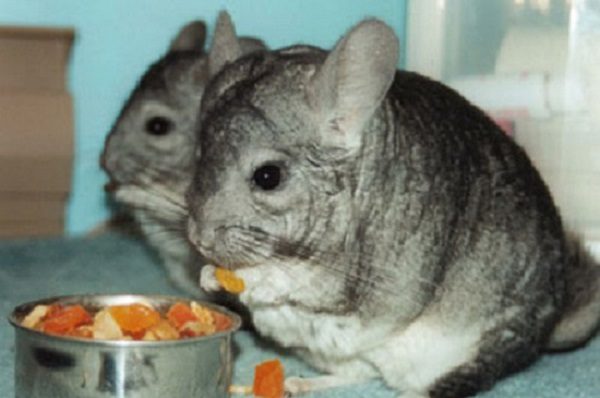
You can feed the beast with flax seeds or corn kernels, leaves of fresh and young nettle, or dandelion, strawberry, and also occasionally give her a piece of dried sweet apple and a carrot, a pear, and a few raisins. But to enter into the diet a fresh apple, cabbage and nuts is undesirable and even contraindicated.
Speaking of what should be excluded from the diet of the chinchilla, then in addition to all the above, never give your pet roasted seeds and seeds, nuts - they are served fresh, but not roasted. You should not give food from your own table. Bread and biscuits - optimally give wheat crackers and then infrequently.
Diseases and their prevention: how to care for a sick animal?
Many ask the question - what diseases are inherent in the chinchilla and what control measures, prevention should be used to prevent? In the list of the most common diseases, veterinarians identified the following:
- Gastrointestinal disorder. The root cause is poor-quality food, expired, the wrong feeding regime, when there is an excess of dry or juicy food, a sharp change in diet and diet. As a result, the animal is diagnosed with constipation or diarrhea, inflammation of the gastrointestinal tract, when the feces come with blood patches. It is mandatory to show the animal to the doctor - he will examine your pet, recommend a course of treatment and a diet.
- A chinchilla gnaws its fur, or if there are several small animals in a cage, then it is from each other. The reasons for this behavior are different - itchy skin or harmful insects, lack of certain vitamins in the diet, especially protein.Show the animal to the doctor who will inspect and take the tests, or change the diet, introducing vitamin supplements into it, and also clean the cage more often.
- Dystrophy of liver cells due to its obesity - here liver cells are replaced by fatty tissue. The reason - this is rancid, poor-quality food, when the body of the chinchilla does not absorb carotene, excessively fat food, a large number of nuts and seeds. The animal simply fed up - reconsider the diet, minimizing fatty foods, choosing only high-quality, fresh food, and also put in the cage wheel for sports activities of your pet.
- Stone formation in the genitourinary system - The cause may be improper diet. You can identify the stones by ultrasound - if they are small, when it’s more like sand, it will come out of the body itself, if its size is larger - they are removed surgically.
- Sunstroke or hypothermia - there are reasons for the wrong temperature regime of the animal. Accordingly, remove the animal from the room too hot for it, from the sun, or transfer to a warmer room.With such a problem, the animal will constantly lie, his breathing becomes intermittent and difficult, loss of consciousness - if this does not help, then it is worth showing the chinchilla to the veterinarian who will prescribe drugs that increase blood flow and respiration.
- Conjunctivitis - inflammation of the conjunctiva of the eyes of the chinchilla. The reason may be injury or chemical irritants, bacteria - show the animal to the doctor who will prescribe the treatment. In addition, clean the cage and treat it with antiseptics, and as prevention and treatment, it is prescribed to wash the eyes with a 3% solution of boric acid or with chamomile broth, plus drops, which include antibiotics.
- Qatar nose - this disease in chinchilla manifests itself when the weather changes, with sharp fluctuations in temperature, if the room has a strong draft. In this case, mucus from the nasal pathways of the animal will leak, the eyes water, and white or yellow discharges accumulate in the corners, the chinchilla eats little, frequent breathing and temperature increase aggravate its condition. In this case, keep the animal standing in a dry room, rinse eyes with a solution of boric acid, give food rich in vitamin C, and consult with a veterinarian.
- Wounds that result from injuring animals between themselves during a fight, or in contact with the sharp edge of a shelf in a cage. If the wounds are superficial - they heal on their own, without any help, but if this is a deep wound - consult a doctor, for washing and processing, in order to avoid infection and the inflammatory process.
- Dental problems. As the animal grows, chinchillas may have problems with their teeth - their excessive growth and periodontal disease. The growth of teeth and the lack of the ability of an animal to grind them, leads to problems with bite and nutrition, chewing food and as a result - problems with the gastrointestinal tract. Remember that chinchilla teeth have an open root - so they grow constantly with them, and if there is a lack of vitamins A and D in the diet, calcium, the teeth will grow too fast. In this case, it is worth carrying out the correction of the teeth - just cutting them in the medical institution and constantly giving the animal hard twigs and products for grinding teeth.
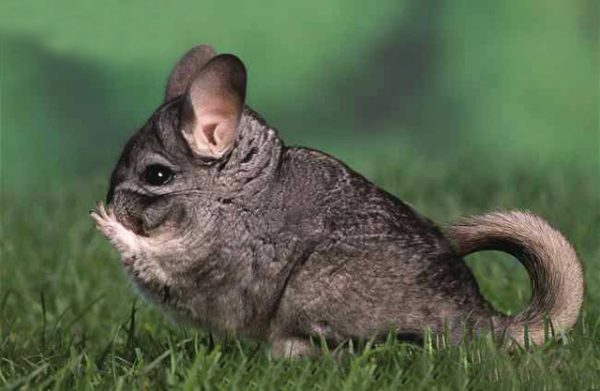
Breeding animals at home in the apartment
How to keep chinchilla at home? If you want to keep a family of chinchillas and start breeding them - it is worth taking into account a few points and rules. Firstly - matriarchy is pronounced in chinchilla families, the supremacy of the female is recommended, therefore, it is recommended to mount the female to the male on its territory, but if the sharing happens on its territory, the pair should be given time to get used to each other, so to speak.
In this case, for a couple of days, put a cage with a male near the cage with a female and only after you sit them together. If the animals behave aggressively - dissolve them in cages for a while and so on until they peacefully live together in a pair. The main thing is to conduct everything under their own control, so that the animals in a fight do not hurt each other.
The male reaches puberty at the age of 8-9 months, the female - at 7-8while the duration of the sexual cycle in the female is about 40-50 days, estrus lasts 3-4 days. The female bears the offspring for 105-110 days - during this period it is recommended to give her an enhanced diet, especially if the animal is the first to become pregnant.
1-2 babies are born, less often - 3 or more, and in caring for offspring the male shows himself to be a rather caring dad. But if you do not want the chinchilla to become pregnant again - for the period of the departure of the female for the offspring, it is recommended to resettle the male in another cage.
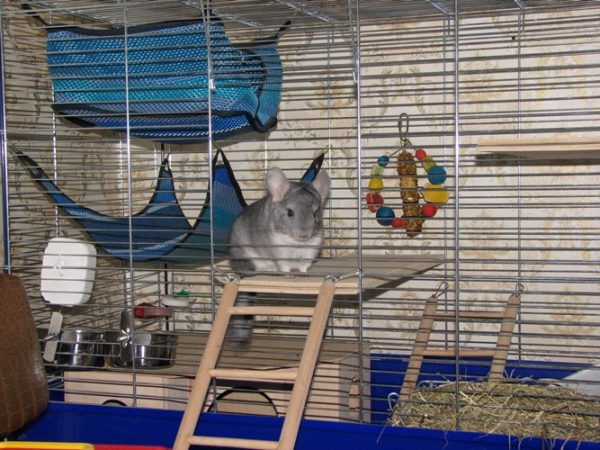
Babies are born already covered with wool, open eyes and can move themselves - their weight varies from 30 to 70 grams and the weight depends on the number of calves in the litter.
If the female has given birth to 2, then feeding them is not necessary, but if 3 or more - artificial feeding from the pipette with milk mixtures will allow to keep the babies. For, so that the female has more milk, let's give 1-2 raisins a day, and after 2 months, babies can be removed from the mother.
As you can see, caring for a chinchilla at home is not so difficult. Chinchilla in the house, care for her and reproduction - an occupation, the power of each.And the joy of caring for a small, fluffy animal you get a lot.
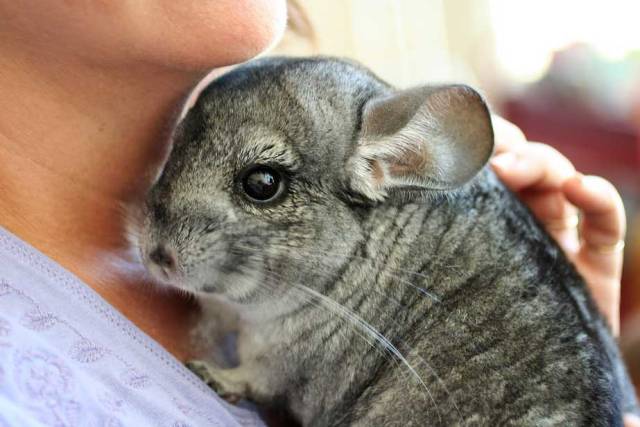
Somehow, finally, it happened that we decided to give our daughter a chinchilla for her birthday! Very cute pet with soft fur) After a month of chinchilla, we realized that the most important thing for this animal is a lot of free space! She looks like a squirrel, who all the time you need to jump from place to place, and if you leave her for a long time in a cage, she is sad. It was also very interesting with sand baths in which the chinchilla bathes